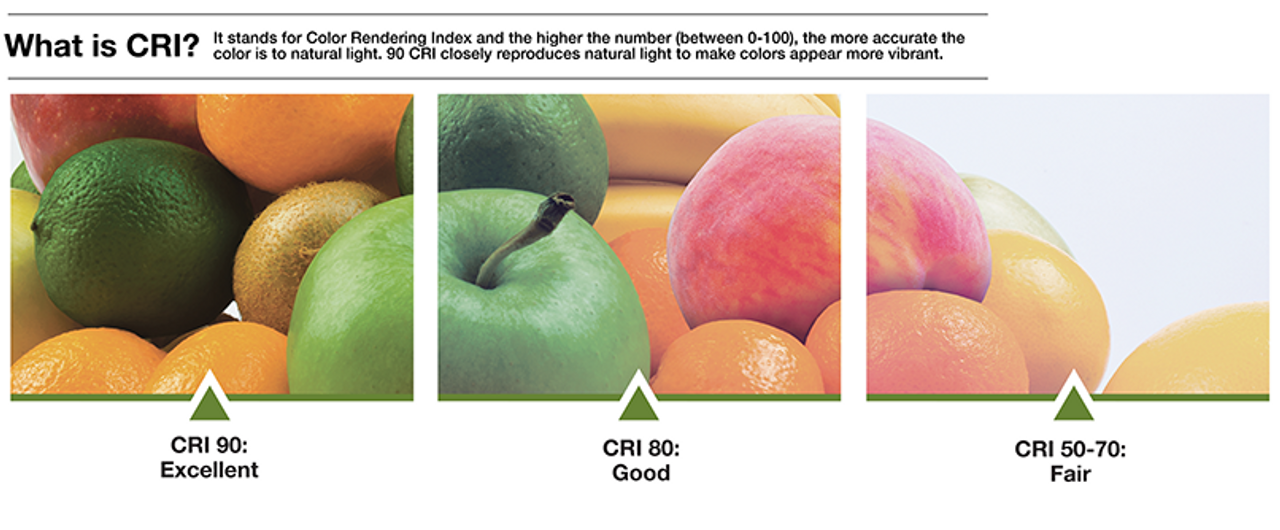How do I choose the correct CRI for my stage lighting fixture?
For many LED stage lighting fixtures, you will need to select the CRI, color temperature and lumens for the fixture. This article describes each of these dimensions of an LED theatrical lighting fixture.
CRI is a (relatively) new buzzword in the lighting community. It applies to certain types of LED lighting and you often have to choose your CRI before making an LED stage lighting fixture purchase. This blog will help you to understand CRI and how to choose the CRI that’s best for your needs.
CRI stands for “Color Rendering Index.” The Color Rendering Index (CRI) is a scale from 0 to 100 percent indicating how accurate a "given" light source is at rendering color when compared to a "reference" light source.
Wikipedia defines the Color Rendering Index as a quantitative measure of the ability of a light source to reveal the colors of various objects faithfully in comparison with a natural or standard light source. Wikipedia goes on to say, "The value often quoted as "CRI" on commercially available lighting products is properly called the CIE Ra value, "CRI" being a general term and CIE Ra being the international standard color rendering index. Numerically, the highest possible CIE Ra value is 100 and would only be given to a source whose spectrum is identical to the spectrum of daylight, very close to that of a black body (incandescent lamps are effectively black bodies), dropping to negative values for some light sources. Low-pressure sodium lighting has a negative CRI; fluorescent lights range from about 50 for the basic types, up to about 98 for the best multi-phosphor type. Typical white-color LEDs have a CRI of 80 or more, while some manufacturers claim that their LEDs achieve a CRI of up to 98.[3]"
CRI is a measure of how well an LED will illuminate a color. Think of an LED fixture illuminating a red apple. With a lower CRI (let’s say 80), the apple will still look like a red apple, but it may not have the depth and accuracy of color of the “real” apple. If you put an apple that is lit by daylight next to an apple lit by an 80 CRI LED, you will notice a difference in color. However, if you use a higher CRI, like 97, the apple will look “truer” to color. You will see little difference between the apple lit by natural light and by a 97 CRI LED.

If you are using LED fixtures to illuminate a theatre production or a worship service, you may not need a very high CRI. However, the CRI becomes more important if you are live-streaming your events. If you are purchasing LED fixtures to illuminate artwork or anything where the color really matters, then you should look for a higher CRI. Usually, the higher the CRI, the more expensive the fixture.
It is important to note that CRI is different that "color temperature” (also referred to as color temp) or the Kelvins of an LED. Color temperature determines how warm (yellow) or cool (blue) the light is. The lower the number (2700-3000K) the warmer the color temperature of the LED. A higher number (5000K or above) will have a cooler color temperature. As a point of reference, "daylight" lighting would have a color temperature of 2700K.
Another factor you may need to consider is “lumens.” Lumens is the “brightness” of a light. You can have an 80 CRI, 2700K LED that is 50 lumens (not as bright) or an 80 CRI, 2700K LED that is 100 lumens (much brighter). It can be described as the “punch” of the brightness. For a higher lumen LED, the light will travel farther across a room (the “throw” of the light) than with a lower lumen LED.
This is a super-basic review of the terms you may need to know when choosing an LED lighting fixture. Should you need additional help, please feel free to contact the “techsperts” at Knight Sound & Lighting!

